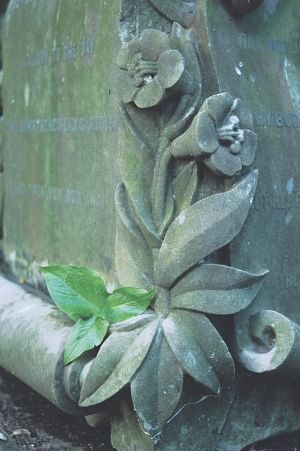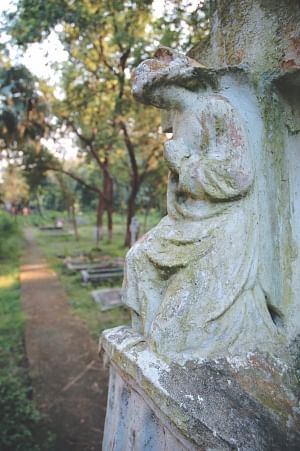| Home - Back Issues - The Team - Contact Us |
 |
| Volume 11 |Issue 31| August 03, 2012 | |
|
|
Heritage A Disappearing 400-year-old Heritage Zyma Islam
Awalk through the serene greenery of Narinda Christian Cemetery gives a slice of Dhaka's 400-year-old history. The graveyard gives a startling perspective about the lives of the European colonisers who had lived and died in the region, something that is often overlooked in historical documentation. Towering mahogany, kalo jam and krishnochura trees shade tombs that date back to the inception of the city. Among these rests the grave of the daredevil American Jeanette van Tassell, whose hot air balloon was the advent of aviation in the subcontinent. But while the cemetery still holds her remains, it is lost among the tangled undergrowth of the neglected graveyard. The only traces of the Dutch and Chinese presence in Bengal too are found in the same cemetery, under the tombstones of William Kerkman and Wonsi Quan. Reverend Joseph Paget, fifth chaplain to Calcutta also remains buried in this graveyard, in a tomb dating back to 1721. A small easily-overlooked epitaph inscribed with the name 'Jane Rennell' belongs to the daughter of James Rennell, the first person to chart Bengal on a map. He is also known worldwide as the father of oceanography. Incidentally, Jane is also the niece of the famous novelist William Thackeray, best known for his novel Vanity Fair. Although many tombs date back to the early 1700's, the cemetery was formally consecrated only in 1828. The year is not too far from the date 1858 when the British assumed direct rule over Bengal, suggesting that robust British settlements with sizeable populations, requiring institutionalised burial grounds, were only created around mid-1800. Thus, the cemetery is a story of the architectural evolution of a city budding from the banks of the Buriganga. The earlier tombs bear vestiges of regional handiwork, but further down the years the tombs become distinctively western. This is where Mughal gave way to the British, red sandstone and clay bricks were replaced, and local craftsmen picked up the trade of gothic masonry. The cemetery with its many ionic columns and gothic crypts has a white Moorish gate. The tomb of a young girl named Beatrice is inlaid with carved daffodils while another tomb bears local flowers crafted in a geometric mosaic. A distinctly Moorish mausoleum houses the body of one Ezekiel Beck whose death ironically occurred in the hands of the Muslim natives, as proclaimed by his epitaph. The more western-looking stonework of the tombs dating 1820 and onwards also implies a stronger inflow of western knowledge. The delicately chiselled figurine of Mother Mary atop the grave of Armenian Elizabeth Marcar David, is clearly more Renaissance than the elongated eyes and painted mouths of the plump Hindu goddesses the local sculptors are used to.
A Roman archway constructed without any keystone is perhaps one of the most intriguing examples of the cultural shift that was happening. Instead of the keystone, bricks had been placed vertically to meet at the pinnacle in a 'V'. Architect Taimur Islam of Urban Study Group, a heritage conservation NGO, working to preserve the cemetery, comments on the unusual build of the archway. “The arch had been constructed following the construction method of the pointed arches of the Mughal period. The key stone is the most important element of a typical western semicircular arch because it holds the arch together and helps the transfer of the load from above to the side walls on which it rests. Apparently the mason, without knowing the construction technique of the Western Arch had only tried to copy the shape of the arch while using the method of a pointed arch,” he said. “This makes the mausoleum all the more important, as a heritage structure. It is probably an example of the transitional period architectural style at the beginning of the British rule,” continues the architect-turned-heritage activist. Proper historical research of the tombstones can also reveal facts about the lifestyle of the European settlers and the Anglo-Indians. Careful study of the dates inscribed on the epitaphs shows that the life expectancy of the Europeans was very low, suggesting a lack of medical facilities customised to the new surroundings. It is possible to assume that rapidly spreading epidemics common to that time, such as malaria and cholera might have been the cause of death of many of the inmates of the cemetery. However, unless rapid attention is given to this heritage treasure-trove, the cemetery will disappear to the ravages of time. Ruins of fallen mausoleums lie in plain sight while those left standing have undergone weather-borne wear and tear. Intricate engravings have now evened out to smooth stone. “We are not allowed inside, so none of us know about the destruction of valuable historical evidence that is going on” says the owner of a tea-stall situated beside the graveyard. The caretaker of the cemetery however says that the graveyard is closed to the general public to maintain the sanctity of the area, and to prevent vandalism. “Over the years, many have removed valuable statues and epitaphs,” he continued, showing empty sockets on graves. He also pointed to a pock-marked tomb, suggesting that it had been covered with gilt. A curious looking moderate sized floral ring laid on the ground might have held a structure earlier, and the caretaker said it could have been a statue. “We also deny people entry because many of the tombs and mausoleums are dangerous and on the verge of falling down. Sitting on an unstable tomb might make it crash down into the crypt below. Just three years back a vagabond sleeping inside a mausoleum was killed by the roof falling in,” he adds. Locals also state incidents of mass razing of old monuments, which had been conducted by the cemetery authorities a decade back to make space for new graves. “The monuments were from the 1600's,” says Hafizur Rahman, a long term resident of Narinda. “I had seen them when I played in the cemetery as a child. They used to be near the back wall of the cemetery.” Unless appropriate measures are taken to declare the cemetery a heritage site there is no guarantee that such incidents will not repeat. Preservation must also be followed up by restoration to slow down the aging process of the monuments. The situation needs to be dealt with urgently or Dhaka might lose some of the last vestiges of its historical glory. Copyright
(R) thedailystar.net 2012 |

